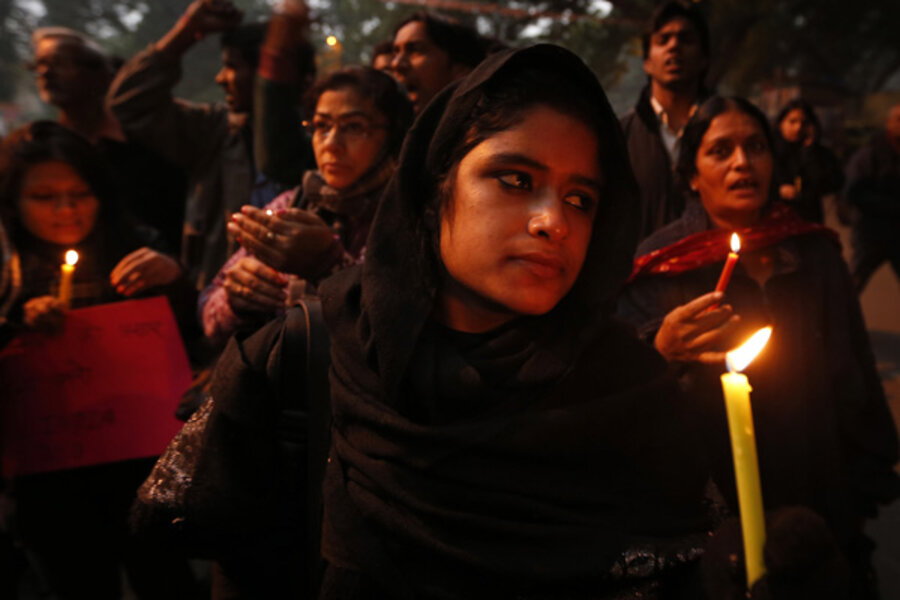Gang-rape victim dies, India transfixed
Loading...
| SINGAPORE
A young Indian woman who was gang-raped and severely beaten on a bus in New Delhi died Saturday at a Singapore hospital, after her ordeal galvanized Indians to demand greater protection from sexual violence that impacts thousands of women daily, in homes, streets, and public transport, but which often goes unreported.
She "passed away peacefully" with her family and officials of the Indian embassy by her side," said Dr. Kevin Loh, the chief executive of Mount Elizabeth hospital where she had been treated since Thursday. "The Mount Elizabeth Hospital team of doctors, nurses and staff join her family in mourning her loss," he said in a statement.
He said the woman had remained in an extremely critical condition since Thursday when she was flown to Singapore from India.
"Despite all efforts by a team of eight specialists in Mount Elizabeth Hospital to keep her stable, her condition continued to deteriorate over these two days. She had suffered from severe organ failure following serious injuries to her body and brain. She was courageous in fighting for her life for so long against the odds but the trauma to her body was too severe for her to overcome."
The woman and a male friend, who have not been identified, were traveling in a public bus after watching a film on the evening of Dec. 16 when they were attacked by six men who took turns to rape her. They also beat the couple and inserted an iron rod into her body. Both of them were then stripped and thrown off the bus, according to police.
Indian police have arrested six people in connection with the attack, which left the victim with severe internal injuries.
Indian High Commissioner, or ambassador, T.C.A. Raghanvan told reporters that the scale of the injuries she suffered was "very grave" and in the end it "proved too much.
He said arrangements are being made to take her body back to India
The crime shocked Indians, who have come out in their thousands for almost daily demonstrations, demanding stronger protection for women and death penalty for rape, which is now punishable by a maximum life imprisonment.
(Read the Monitor's roundup of how the gang-rape started a national dialogue on women's safety)
But the tragedy has also forced India to confront the reality that sexually assaulted women are often blamed for the crime, which forces them to keep quiet and not report it to authorities for fear of exposing their families to ridicule. Also, police often refuse to accept complaints from those who are courageous enough to report the rapes and the rare prosecutions that reach courts drag on for years.
After 10 days at a New Delhi hospital, the victim was brought to the Mount Elizabeth hospital, which specializes in multi-organ transplant. But by late Friday, the young woman's condition had "taken a turn for the worse" and her vital signs had deteriorated. It was clear then that she would not survive long.
Indian attitudes toward rape are so entrenched that even politicians and opinion makers have often suggested that women should not go out at night or wear clothes that might be seen provocative.
Other politicians have come under fire for comments insulting the protesters and diminishing the crime.
On Friday, Abhijit Mukherjee, a national lawmaker and the son of India's president, apologized for calling the protesters "highly dented and painted" women, who go from discos to demonstrations.
"I tender my unconditional apology to all the people whose sentiments got hurt," he told NDTV news.
Separately, authorities in Punjab took action Thursday when an 18-year-old woman killed herself by drinking poison a month after she told police she was gang-raped.
State authorities suspended one police officer and fired two others on accusations they delayed investigating and taking action in the case. The three accused in the rape were only arrested Thursday night, a month after the crime was reported.
"This is a very sensitive crime, I have taken it very seriously," said Paramjit Singh Gill, a top police officer in the city of Patiala.
The Press Trust of India reported that the woman was raped Nov. 13 and reported the attack to police Nov. 27. But police harassed the girl, asked her embarrassing questions and took no action against the accused, PTI reported, citing police sources.
Authorities in the eastern state of Chhattisgarh also suspended a police officer on accusations he refused to register a rapecomplaint from a woman who said she had been attacked by a driver.
--------
Associated Press writer Faris Mokhtar contributed to this report.







